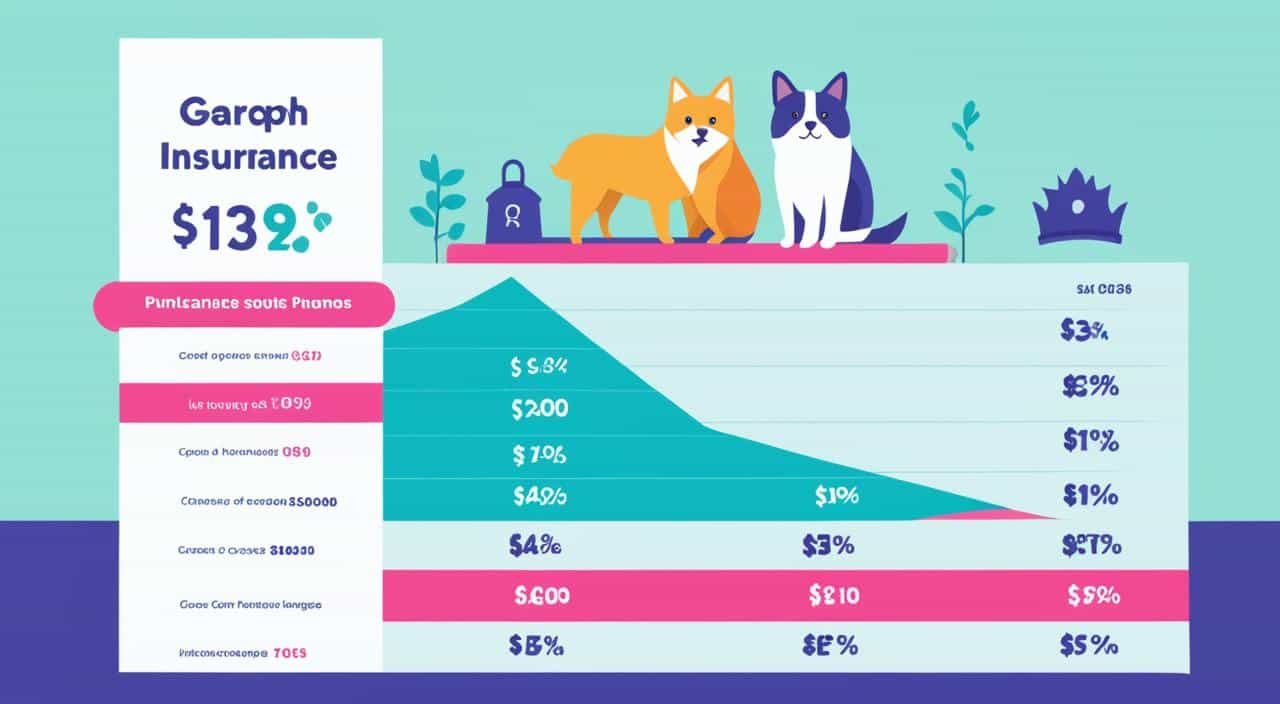Pet insurance is now a common choice for pet owners to handle the high costs of vet care. It offers financial protection against unexpected vet bills. This means pet owners can get their pets the care they need without spending too much money.
Pet insurance helps by cutting down on out-of-pocket costs. It also lets pet owners choose any vet they want, without limits. This makes it a smart choice for many pet owners.
Key Takeaways
- Pet insurance can significantly reduce out-of-pocket veterinary expenses, with the average annual cost ranging from $130 to $584 depending on the type of coverage and pet.
- Pet insurance can eliminate the need to choose between financial well-being and a pet’s health, providing access to a wide range of veterinarians without network restrictions.
- Pet insurance can offer relatively low deductibles to limit out-of-pocket costs, but may have limitations in covering pre-existing conditions or certain health issues.
- The cost of pet insurance can be a drawback, especially for older pets or certain breeds, but the potential benefits may outweigh the costs for many pet owners.
- Overall, pet insurance is worth considering for many pet owners to help manage the often-high costs of veterinary care and provide financial protection for their furry friends.
Introduction to Pet Insurance
Pet insurance is now more popular, helping pet owners cover unexpected vet bills. It covers many medical treatments, giving peace of mind and financial security.
Definition of Pet Insurance
Pet insurance covers your pet’s medical care, like check-ups, accidents, and illnesses. It works like human health insurance. You pay a monthly or yearly premium. Then, the insurance company pays part of your vet bills.
Insurance policies have a deductible, which is what you pay first. After that, the insurance covers a part of the costs. You pay the rest.
Getting pet insurance can be a smart move for pet owners. It helps with the cost of emergencies or ongoing health issues. This way, your pet can get the care they need without worrying about the cost.
“Pet insurance can be a lifesaver for pet owners, providing financial protection and peace of mind in times of medical emergencies or unexpected illnesses.”
Also Read :What Foods Should You Avoid With High Blood Pressure?
Types of Pet Insurance Coverage

There are several types of pet insurance to consider. Knowing the differences helps pet owners pick the best plan for their pets.
Accident-only Pet Insurance
Accident-only pet insurance covers unexpected injuries or accidents. This includes things like broken bones, cuts, or swallowing something they shouldn’t. It’s usually cheaper than other plans but doesn’t cover illnesses or regular vet visits.
Accident and Illness Pet Insurance
Accident and illness pet insurance covers a lot more. It includes protection for many medical issues, like hereditary conditions, testing, procedures, and medications. This is great for pet owners who want their pets to get the best care.
Routine Wellness Pet Insurance
Routine wellness pet insurance covers preventative care. This means things like wellness exams, vaccines, and flea and heartworm prevention. These plans cost more but help pet owners budget for regular vet visits and keep their pets healthy.
| Type of Coverage | What It Covers | Typical Cost |
|---|---|---|
| Accident-only | Unexpected injuries or accidents | Lower premiums |
| Accident and Illness | Wide range of medical conditions, including hereditary, testing, procedures, and medications | Higher premiums |
| Routine Wellness | Preventative care, such as wellness exams, vaccines, and flea/heartworm prevention | Highest premiums |
Understanding the different pet insurance options helps pet owners make a smart choice. They can pick a plan that meets their needs and budget.
Also Read : What Are The Fees And Interest Rates For Payday Loans?
What Pet Insurance Covers

Pet insurance can cover a lot of veterinary costs your pet might face. It helps with accidents, injuries, illnesses, and chronic diseases. This makes caring for your pet’s health less expensive.
- Accidents and Injuries: Pet insurance covers unexpected injuries like broken bones or bite wounds.
- Illnesses and Chronic Conditions: It also covers illnesses and chronic diseases, including infections, cancer, and diabetes.
- Dental Issues: Some policies cover dental cleanings, extractions, and other dental treatments.
- Hereditary and Congenital Conditions: Some plans cover genetic or inherited conditions like hip dysplasia.
- Surgical Procedures: Pet insurance can help pay for surgeries, including cancer treatments and emergency operations.
- Prescription Medications: Many plans reimburse for prescribed medications for your pet’s conditions.
- Diagnostic Testing: It covers diagnostic tests like X-rays and blood work to find and treat health issues.
- Emergency Care: In emergencies, pet insurance covers critical care and stabilization.
- Alternative Treatments: Some plans cover alternative therapies like acupuncture or physical therapy.
- Behavioral Modification: Some plans also cover training or behavior modification programs.
Make sure to check the details of any pet insurance policy you’re looking at. This way, you know it fits your pet’s needs and your budget.
Also Read :How Do I Choose The Right Small Business Insurance Policy?
What Pet Insurance Doesn’t Cover
Pet insurance can be a big help for your furry friends. But, it’s key to know what it doesn’t cover. Understanding what’s not included can help you plan for extra costs.
Pre-existing conditions are often not covered. If your pet had a health issue before you got insurance, it might not be covered. Also, things like yearly check-ups, shots, and preventive care are usually not part of standard pet insurance.
- Cosmetic procedures and elective surgeries, like tail docking or ear cropping, are typically not covered.
- Pet insurance may also exclude boarding, daycare, and property damage or liability claims related to your pet’s behavior.
- Some policies may not cover the cost of spay/neuter procedures or certain pet supplies.
Always read the policy details carefully before getting pet insurance. This way, you won’t be surprised later and can make sure you have the right coverage for your pet.
“Knowing the limitations of pet insurance can help you plan for potential out-of-pocket expenses and make the best decision for your pet’s health and your budget.”
Average Cost of Pet Insurance

Pet insurance costs can change a lot based on several things. These include the type of coverage, the pet’s age and breed, the deductible amount, and where you live. Knowing these can help pet owners pick the right insurance plan for their pets.
Also Read :How Do I Avoid Predatory Loans?
Accident-only vs. Accident and Illness Coverage
Accident-only pet insurance plans are cheaper, costing $15 to $30 a month for dogs and $10 to $20 for cats. On the other hand, accident and illness plans, which cover more, cost $30 to $70 a month for dogs and $20 to $40 for cats.
Factors Affecting Pet Insurance Costs
- Pet Age: Young pets pay less for insurance, but older pets pay more because they’re at higher risk of health issues.
- Pet Breed: Some breeds get sick more often, so they pay more for insurance.
- Deductible: A higher deductible means lower monthly payments, but a lower deductible means higher payments.
- Location: Where you live can change how much you pay for pet insurance, with cities usually costing more.
- Wellness Coverage: Adding wellness coverage, like regular vet visits and preventive care, makes the insurance cost go up.
Pet owners should think about their pet’s needs and their budget when picking a pet insurance plan. By knowing what affects pet insurance costs, they can choose the best plan for their pets.
Pet Insurance

Pet insurance offers crucial financial protection and peace of mind for pet owners. It helps cover unexpected vet costs. This way, pet owners can give their pets the care they need without worrying about the cost.
Pet insurance helps cover vet bills for accidents, injuries, and illnesses. This is especially useful for unexpected vet costs. For example, a broken bone or a swallowed object can lead to high vet bills. Pet insurance can help pay for these costs, easing the financial strain.
It also gives pet owners peace of mind. Knowing their pets are covered by insurance means they can focus on their pets’ health. This leads to better care decisions and ensures pets get the quality care they deserve.
| Coverage | Deductible | Reimbursement | Policy Limits |
|---|---|---|---|
| Accident and Illness | $250 | 80% | $10,000 per year |
| Routine Wellness | $50 | 100% | $500 per year |
Pet insurance is a smart choice for pet owners. It offers financial protection and peace of mind. This way, pets can get the best care without worrying about unexpected vet bills.
Also Read : What Are Common Lung Diseases?
Cons of Pet Insurance
Pet insurance has many benefits, but it’s important to look at the downsides too. From pre-existing conditions to coverage limits, knowing these can help pet owners decide if insurance is right for their pets.
One big issue is that many policies won’t cover pre-existing conditions. This means if your pet had a health problem before you got insurance, you might not get help for it. This is tough for older pets or those with health issues.
Another thing to consider is how insurance works. You pay for vet care first and then try to get some money back. This can be hard on families with tight budgets.
Also, pet insurance has limits on what it covers. You might have to pay a lot of money for your pet’s care. These limits can include yearly payout caps, not covering some treatments, or high deductibles.
Older pets and certain breeds can also face challenges with insurance. Older pets are more likely to get sick, and some insurers might not want to cover them or charge more. Some breeds have health problems that insurance might not cover.
Lastly, some insurance plans don’t cover wellness care. This means you might have to pay for routine vet visits, shots, or other preventive care yourself.
In conclusion, pet insurance can be a good choice for many, but it’s important to think about the downsides. Knowing what insurance doesn’t cover can help you make a choice that fits your pet and your budget.
Is Pet Insurance Worth It?
Is pet insurance worth it? It depends on your situation. For many, it offers financial protection and peace of mind. Let’s look at the costs to see if it’s a good investment.
Cost Comparison
The average cost of pet insurance is $300 to $700 for dogs and $200 to $500 for cats each year. This might seem high, but think about the costs without insurance.
Without insurance, one sudden vet bill can be thousands of dollars. This can lead to financial stress and hard choices for owners. Regular vet visits, treatments, and managing health issues also add up. So, for many, pet insurance is a smart choice.
Not every pet owner needs pet insurance. But think about your budget, your pet’s health, and the chance of unexpected vet bills. This can help you decide if pet insurance is right for you.
“Pet insurance can provide a financial safety net, allowing pet owners to focus on the well-being of their furry friends without worrying about the cost of veterinary care.”
Also Read: How Do I Find The Best Insurance Policy For Me?
Conclusion
Pet insurance offers big benefits for many pet owners. It covers unexpected vet bills for accidents, injuries, and illnesses. This means pets get the care they need without making their owners spend too much money.
This can give pet owners peace of mind. It also means better healthcare for their pets. Pet insurance is a smart choice for those who want to protect their pets’ health.
Even though some conditions aren’t covered, pet insurance is still a good deal for many. It helps keep pet owners from going broke over unexpected vet bills. So, it’s a smart move for those who want to keep their pets safe and healthy.
Choosing pet insurance is a personal decision. But the facts show it’s a great choice for those looking for pet insurance benefits, financial protection, and peace of mind. By looking at their own needs and budget, pet owners can pick a plan that fits them well.
FAQs
Q: What are the benefits of pet insurance?
A: Pet insurance can help pet owners cover unexpected veterinary costs, provide peace of mind, and ensure their pets receive necessary medical care without financial strain.
Q: How can I find the best pet insurance for my pet?
A: To find the best pet insurance, compare pet insurance companies, consider your pet’s specific needs, evaluate coverage options, and read customer reviews.
Q: How much does pet insurance cost?
A: The cost of pet insurance varies based on factors like your pet’s age, breed, location, and the level of coverage you choose. On average, pet insurance can range from $20 to $60 per month.
Q: What does pet insurance typically cover?
A: Pet insurance usually covers accidents, illnesses, emergency care, surgeries, hospitalizations, medications, and sometimes routine care like vaccinations and preventive treatments.
Q: Is pet insurance worth it for pet owners?
A: Pet insurance can be worth it for pet owners, especially if they want to protect their pet’s health, be prepared for unexpected medical expenses, and ensure they can afford the best care for their furry companions.
Q: Can I get pet insurance for both dogs and cats?
A: Yes, there are pet insurance plans available for both dogs and cats. Some insurance providers offer customizable policies that can cover multiple pets in a household.
Q: Which are the best pet insurance companies of 2024?
A: The best pet insurance companies of 2024 may vary based on reviews, ratings, and the specific needs of pet owners. Popular options in 2024 include Pets Best, Embrace Pet Insurance, and ASPCA Pet Insurance.
Source Links
- https://www.avma.org/resources-tools/pet-owners/petcare/do-you-need-pet-insurance
- https://www.empower.com/the-currency/play/pros-cons-pet-insurance
- https://www.pawlicy.com/blog/is-pet-insurance-worth-it/




